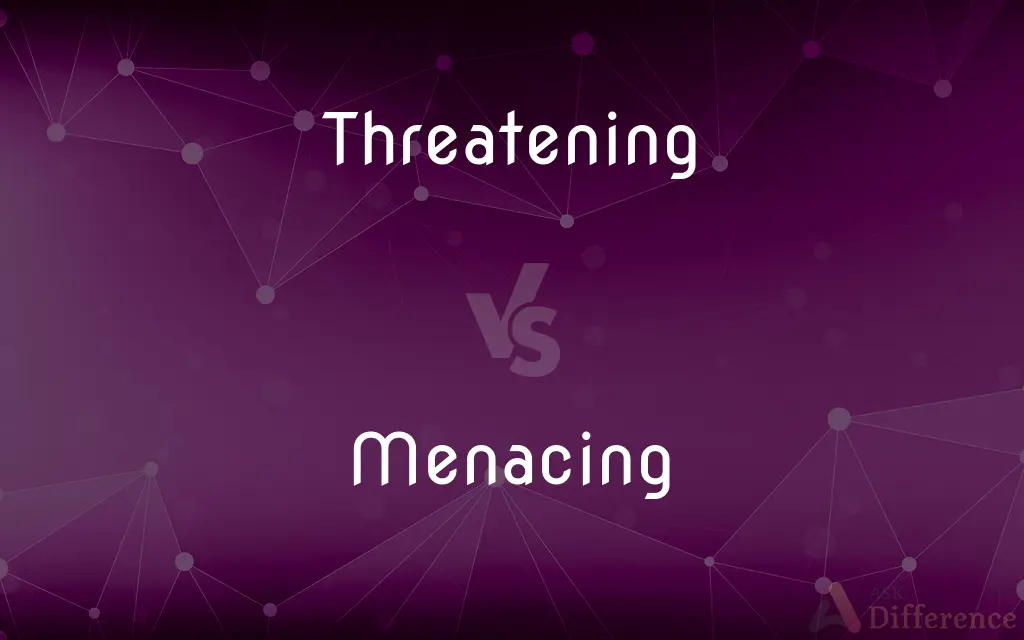Threatening vs. Menacing — What's the Difference?
Edited by Tayyaba Rehman — By Urooj Arif — Updated on April 21, 2024
Threatening implies a direct expression of intention to cause harm, while menacing suggests a more general aura of danger or the potential to cause fear.

Difference Between Threatening and Menacing
Table of Contents
ADVERTISEMENT
Key Differences
Threatening often involves explicit statements or actions that indicate an intent to inflict pain, damage, or other hostile action on someone. Whereas, menacing might not involve direct threats but instead creates an atmosphere or sense of danger that alarms others.
The term "threatening" can be used in both legal and personal contexts, usually referring to verbal or physical behavior intended to coerce or intimidate. On the other hand, "menacing" often describes a presence or behavior that implies a hidden threat, which can be vague but still powerful enough to instill fear.
Threatening is specific and clear in its expression, making it easier to identify and address in scenarios such as law enforcement or personal safety. Meanwhile, menacing can be more subjective and elusive, often related to the way a person or situation feels rather than explicit actions.
In interpersonal dynamics, a threatening individual communicates directly what harm they may cause, setting clear expectations of their intentions. Whereas menacing behavior might involve more indirect methods, such as body language, facial expressions, or even the setting, which conveys a threatening subtext without words.
When considering legal repercussions, threatening behavior can lead to charges such as assault or terroristic threats based on the explicitness of the threat. In contrast, menacing might be used to describe actions that contribute to charges like harassment or stalking, which are often based on creating a pervasive sense of fear.
ADVERTISEMENT
Comparison Chart
Definition
Expressing an intention to harm
Creating a sense of potential harm
Communication Style
Direct and explicit
Indirect and implicit
Legal Context
Can lead to assault charges
Often associated with harassment
Impact on Recipient
Causes immediate fear or coercion
Instills a lingering sense of danger
Examples of Behavior
Verbal threats, physical aggression
Intimidating presence, eerie silence
Compare with Definitions
Threatening
Likely to cause damage or danger.
The dark clouds looked threatening enough to cancel the picnic.
Menacing
Suggesting the presence of danger.
The stray dog had a menacing growl.
Threatening
Expressing or implying a threat.
His threatening voice made everyone uneasy.
Menacing
Seeming likely to cause harm.
The figure in the alley was menacing in the dim light.
Threatening
Involving an ultimatum.
She received a threatening call demanding payment.
Menacing
Intimidating or threatening indirectly.
The villain’s smile was subtly menacing.
Threatening
Serving as a sign of potential harm.
The letter contained a threatening message.
Menacing
Involving an unspoken threat.
There was a menacing tone to his laughter.
Threatening
Intimidating or coercive.
The manager's threatening demeanor kept the employees in constant fear.
Menacing
Creating a feeling of being threatened.
His silent, menacing approach was unsettling.
Threatening
Making or implying threats
A threatening phone call.
Menacing
Menacing or brandishing is a criminal offense in many U.S. states generally defined as displaying a weapon with the intent of placing another person in fear of imminent physical injury or death. Depending on state, degrees of offense range from a misdemeanor for first-time offenders, to low- to mid-level felonies for offenders with a prior menacing charge.
Threatening
Gving warning signs of bad weather
Threatening skies.
Menacing
A possible danger; a threat
A careless driver who was a menace to public safety.
Threatening
Causing the feeling that one's power, social standing, or self-esteem is in danger of being diminished
Found the criticism threatening.
Menacing
The quality of being threatening
A hint of menace in his voice.
Threatening
Present participle of threaten
Menacing
A troublesome or annoying person
Considered her little brother to be a menace.
Threatening
Presenting a threat, posing a likely risk of harm.
Never turn your back to someone who is displaying threatening behavior.
Menacing
To constitute a threat to; endanger
Rome was menaced by invading armies.
Threatening
Making threats, making statements about a willingness to cause harm.
Menacing
Synonym of threateningin its various senses.
Threatening
An act of threatening; a threat.
Menacing
Present participle of menace
Threatening
Threatening or foreshadowing evil or tragic developments;
A baleful look
Forbidding thunderclouds
His tone became menacing
Ominous rumblings of discontent
Sinister storm clouds
A sinister smile
His threatening behavior
Ugly black clouds
The situation became ugly
Menacing
The act of making menaces or threats.
Threatening
Darkened by clouds;
A heavy sky
Menacing
Threatening or foreshadowing evil or tragic developments;
A baleful look
Forbidding thunderclouds
His tone became menacing
Ominous rumblings of discontent
Sinister storm clouds
A sinister smile
His threatening behavior
Ugly black clouds
The situation became ugly
Common Curiosities
Is "menacing" always illegal?
Not always; it depends on the context and if it leads to actions like stalking or harassment.
Can weather be described as threatening or menacing?
Yes, weather can be described as threatening when severe harm is expected, and menacing if it creates an ominous atmosphere.
What is the main difference between threatening and menacing?
Threatening directly states intent to harm, whereas menacing implies danger more subtly.
Can a situation be menacing without specific threats?
Yes, a situation can be menacing through a general aura of danger without explicit threats.
How do people typically respond to threatening versus menacing behavior?
Threatening behavior may provoke immediate defensive responses, while menacing might cause prolonged anxiety or fear.
How do law enforcement agencies treat menacing behavior?
Menacing behavior can lead to investigations, especially if it implies potential harm or intimidation.
Are threatening and menacing interchangeable in writing?
They can be, depending on context, but threatening is more direct while menacing is more about the mood or tone.
What kind of body language is considered menacing?
Subtle gestures like staring, stalking, or blocking someone’s path can be seen as menacing.
Can animals exhibit threatening or menacing behavior?
Yes, animals can be threatening with clear aggressive actions or menacing through their demeanor and presence.
Is it easier to prove threatening or menacing in court?
Threatening is generally easier to prove due to its explicit nature compared to the more subjective interpretation of menacing.
Share Your Discovery

Previous Comparison
Assignation vs. Assignment
Next Comparison
Anyone vs. EveryoneAuthor Spotlight
Written by
Urooj ArifUrooj is a skilled content writer at Ask Difference, known for her exceptional ability to simplify complex topics into engaging and informative content. With a passion for research and a flair for clear, concise writing, she consistently delivers articles that resonate with our diverse audience.
Edited by
Tayyaba RehmanTayyaba Rehman is a distinguished writer, currently serving as a primary contributor to askdifference.com. As a researcher in semantics and etymology, Tayyaba's passion for the complexity of languages and their distinctions has found a perfect home on the platform. Tayyaba delves into the intricacies of language, distinguishing between commonly confused words and phrases, thereby providing clarity for readers worldwide.














































